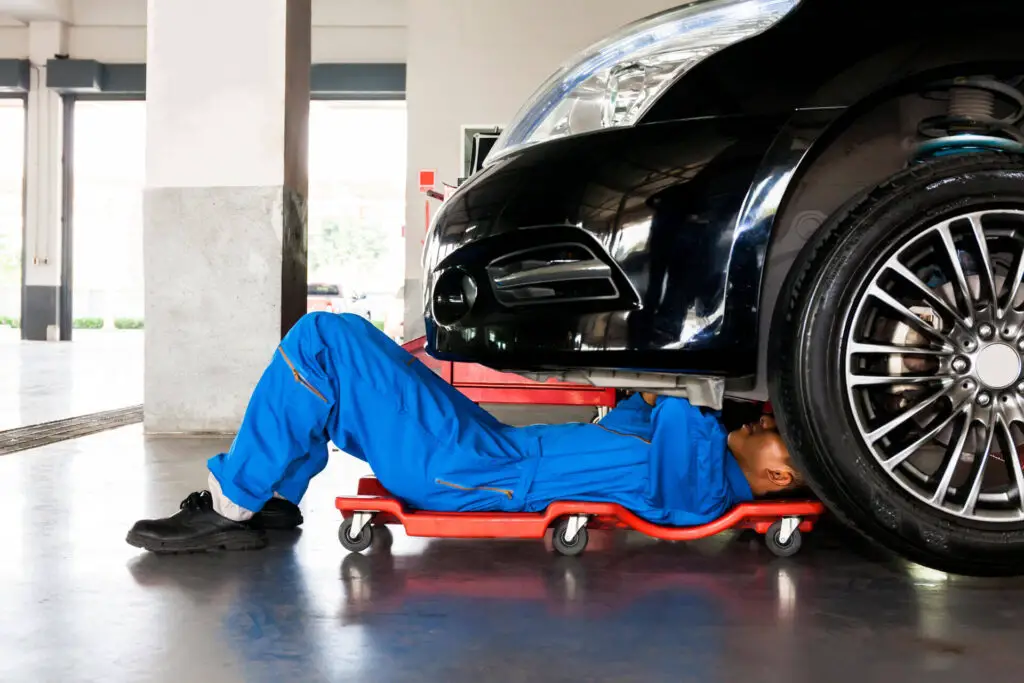Your car is made out of many components that keep it running like a well-oiled machine. Some of those parts get worn out and need to be replaced after a while. And since you can’t drive without them, it’s important to know when to replace brake pads.
What Are Brake Pads and Why Are They Important?
Brake pads are one of the most important parts of the car braking system. Without them, your car wouldn’t be able to stop on your command, it would simply keep going until it hit something, and I think we can all agree that’s not the best way of stopping your vehicle. Luckily, the braking system has been perfected on modern vehicles, but even during the evolution of cars – its principle stayed the same. The braking system on all modern cars today is operated by a hydraulic system, just like it was at the beginning.
The only difference is the fact that all modern cars use four-wheel disc brakes, while older models usually have drum brakes, which have become outdated because of their force and heavy maintenance. You should also know that four-wheel disc brakes can either be floating disc brakes or fixed disc brakes. Another important thing to remember is that brakes, brake shoes, and brake pads are not the same thing.
Brakes are a term used in general for the entire braking system, especially the pedals that you step on and press when you want to stop the vehicle. Brake shoes are an essential part of drum systems. They carry the brake lining inside the drums and create friction that causes the car to stop. Brake pads are a part of disc braking systems, and they’re a flat piece of metal, usually steel, surrounded by some kind of a thick friction material layer on its side.
How Do They Work?
In order to explain how brake pads work and what their role in the entire braking system is, you need to know a bit more about the actual mechanisms behind the braking system and what makes your car come to a stop at high speeds. The best way to understand this mechanism is by picturing yourself riding a bike. Believe it or not, the same physics principles apply when you’re trying to make your bike and your car, truck, or SUV stop, even though the speed and weight of all vehicles are vastly different.
When you’re riding your bike and you wish to slow down or fully stop moving, you would simply squeeze the braking lever as hard as you can, and that lever would cause a pair of small rubber pads to press against the bike wheel. The pressure these braking pads put on the wheel would cause friction and force your bike to stop. So, now that you know how the braking process works in general, what do brake pads actually do in case you want to stop a car? Brake pads cause friction that turns kinetic energy into thermal energy and stops your vehicle.

What Types of Brake Pads Exist?
Brake pads exist with the simple task of creating fiction so the car can stop. A detail that helps them create friction and complete this task is the fact that each pad contains a specific material on its side that is used to maximize friction. These friction materials have the role of maximizing the grip they have on rotors. And since they cause kinetic energy to transform into thermal energy, brake pads, along with these materials, have to be able to withstand high temperatures (670 degrees Fahrenheit and higher). Depending on which material is on them, there are 4 types of brake pads that people use.
Semi-Metallic
This is the most popular type amongst regular day-to-day cars, but they are also often used in race cars or high-performance cars. They are mostly used in newer, high-priced car models. Semi-metallic brake pads are made from 30% to 65% metal, and they could contain wire, steel wool, and copper as additional materials. They are quite inexpensive, but they also get worn out relatively quickly. They are easier on the rotors than the other kinds of brake pads, but they are also louder, and no muffler is gonna fix that. Semi-metallics are quite heavy, so they’re great for stopping heavy vehicles like trucks. Pretty much the only big con of this type is the fact that they don’t perform that great in colder climates and lower, extremely cold temperatures, no matter how great your winter tires are.
Ceramic (Made Out of Ceramic Fibers)
Ceramic (Made Out of Ceramic Fibers)
This type is made out of ceramic fibers. They also contain filler material, copper fibers, and bonding agents. They are known for being very durable and lightweight, and they offer excellent braking performance. Ceramic brake pads don’t get worn out quickly, they will last a long time, but once they need to be changed, you should be warned that they are really expensive. They can withstand very high temperatures, which makes them perfectly suited for race cars and other high-performance vehicles like sports cars that have to come to a full stop from fast speeds in a matter of seconds. Since they are so expensive, it’s worth it for faster cars that go from 0-60 in a heartbeat, but if you’re just planning to drive your average day-to-day car around town, it really doesn’t pay off.
Organic (Nonasbestos Organic)
All the other types of brake pads were formerly made by using asbestos to maximize friction. This material was excellent for absorbing and dissipating heat at high temperatures. The only problem with this material is that it produces dangerous dust particles as it gets used and worn out. Every type creates dust when getting worn out, it’s normal, but only asbestos creates dust that is toxic to inhale. This problem is being solved by creating new brake pads that are made out of nonasbestos, organic materials that are safer for the driver, passengers, and the environment.
Organic brake pads are made from natural materials such as rubber or glass. They usually have a component called Kevlar, and the heat often helps keep the brake pads and their materials intact and together. The biggest improvement this type brought was the fact that they don’t pollute the environment as much as other types do, and they are much easier and eco-friendly to dispose of. They’re also much softer than other kinds, and they’re quieter.
The only problem is that they wear out pretty quickly because they’re made out of softer materials, which produce a lot more dust. The upside is that they are relatively cheap to replace. Organic brake pads are best suited for smaller city cars that don’t drive at high speeds or need hard stops. They are definitely not suited for heavy-duty vehicles, off-road driving, or sports cars since they’re made of such soft materials.
When Do I Need to Replace Brake Pads – Regularly Maintain Your Car to Know
When it comes to car maintenance, most people who aren’t the biggest car enthusiasts tend to focus on maintaining the exterior of the car – they wash it, change a flat tire when they need to, they will change windshield wipers when they stop working, as well as a tail light, but they probably won’t remember to check their car brakes.
Brake maintenance is extremely important since it’s the only thing that can stop your vehicle from crashing into another one while you’re behind the wheel. So, don’t take your car to the mechanics only when there is some kind of an issue. You need to have your car serviced at least once a year when the mechanic will check to see if everything is alright with your brakes.
Your brake pads are constantly exposed to high temperatures, so it’s perfectly normal that they wear and tear after a while. They are one of the many components of your car that are meant to be replaced after some time. The friction material on them gets thinner and thinner with use, and it needs to be at least 3-6 mm thick or it needs replacing.
Otherwise, if they’re completely thinned out, they can not only cause your car to stop harder, but they can also cause damage to other parts of your car. But how do you know when you need to replace them? For starters, your mechanic should check and replace them if they’re too thin. The standard rule is that brake pads need to be changed every 10,000-20,000 miles to keep them healthy and functioning properly.

When to Replace Brake Pads and Rotors and Fluid – Maintenance is the Key
When it comes to the car’s braking system, there are other parts that gets used up with time. Your brake fluid and rotors need replacing as well. Of course, your mechanic will let you know upon the inspection if there are any issues, but the general rule is that you need to replace your rotors after 50,000-70,000 miles.
They are also exposed to high temperatures and can wear out quickly. When it comes to your brake fluid, the general rule to follow is that you should replace it after a few years, or after 50,000 miles, around the same time you should replace your rotors. In the meantime, make sure to watch out for any leaks, since they could compromise your ability to stop the vehicle.
How Can I Tell If Something Is Wrong With My Car Braking System?
Besides the regular checkups at the mechanics, there are more ways you can tell if there is something wrong with your brake pads or braking system in general. These signs are pretty easy to notice, and if you do come across any of them, take your car to the mechanics immediately. Here are some indications your brake pads need changing or something else is wrong with your braking system:
- Your low brake pad indicator light is on the dashboard,
- You can hear an unusual squealing or grinding noise when braking,
- You can sense a burning smell,
- You can feel your pedal pulsating or your steering wheel shaking while you brake.
Be a Conscious Driver and Take Care of Your Car, Your Brakes Will Thank You for It
Believe it or not, there is a simple way you could make your brake pads last longer, and it’s something you should already be doing – drive carefully and consciously. Every time you get behind the wheel and fasten your seat belt, you should be aware of the fact that while a car is a sturdy machine, it’s gentle at the same time, and you should take care of it and treat it with respect. The better you treat your car, the longer it will last. So try to avoid sudden braking at high speeds and hard braking in general. Do it slowly and gently, and leave enough time and space to properly stop, your car will thank you for it.








